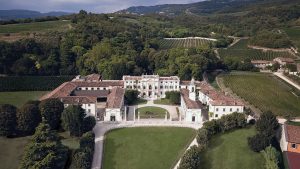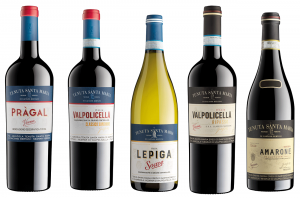Family history is an important signifier of identity for wine producers and their wines. So when Gaetano Bertani and his sons, Giovanni and Guglielmo, left the Cav G.B. Bertani company ten years ago, in 2011, they were in fact going back to the future. The Bertani family has an illustrious history in the world of Veronese wines, making what was arguably the first modern dry Valpolicella, a pioneering dry appassimento wine called Recioto Secco in the 1920s, and the first modern Amarone in the 1950s.
Tenuta Santa Maria was created as a personal project by Gaetano Bertani in the early 1990s and named after a parish in Valpolicella. Today, the estate includes two wineries and properties with diverse terroirs in the DOC/G regions of Arbizzano di Negrar (Valpolicella Classica), Valpantena and Val d’Ilasi. The company headquarters is on one of Valpolicella Classica’s most beautiful estates, Villa Mosconi-Bertani, just outside Verona, with its own authentic walled vineyard.
What’s the future for Valpolicella when produced by a family-owned, terroir-conscious estate? Giovanni is quite clear about this: “We have to move away from the identification of the Verona region as a generic style of winemaking and instead focus on the great variety of soils, climatic conditions and grape varieties, across several different valleys making Amarone, Ripasso and Valpolicella. We have to make individual wines that express each single terroir.”
Family means everything in Tenuta Santa Maria, even in terms of their wine style. Guglielmo Bertani explains:
“We think fine winemaking is first and foremost careful and sustainable farming with vinification techniques focused on low intervention and preserving what has been achieved in the vineyard. The family signature style is to reflect the realities of the land with elegance rather than making standardised commercial products.”
“What we are all about,” says Guglielmo, “is a balance between consistency and a constant search for refinement over generations. We aim to make elegant and lively wines, balanced in every aspect. They are the full expression of each parcel and of varieties grown with a great potential for ageing, even the whites.”
“To achieve this we treat each parcel and its respective variety as a separate single vineyard with its own dedicated management,” Giovanni says. “Each parcel has separate harvest times, separate appassimento in the case of Amarone and separate micro-vinification. In the case of blends the different varieties are handled separately until assemblage, just before bottling.”

Villa Mosconi-Bertani with the Brolo vineyard wall just visible above it
One of the most obvious vineyards for separate management is the spectacular 22-hectare Brolo (what the French would call a Clos), the vineyard enclosed by 4 metre-high walls dating back to the 1500s, erected around the best parcels on the estate in the Arbizzano Valley. The limestone-over-marl soil imparts unique mineral character to the grapes and is sub-divided into smaller parcels, planted to Corvina, Corvinone, Rondinella and Oseleta, used to produce Amarone Classico Riserva. The specific clone of Corvina found here is indigenous to the Brolo and there are plans to reintroduce rarer indigenous varieties, such as Dindarella, Spigamonte and Negrara, to further improve diversity and complexity.
Appassimento and Valpolicella wines
“Appassimento, or grape drying as a winemaking method, originated during the time of the Ancient Romans as a way of making bigger and sweeter wines that suited contemporary tastes,” Giovanni explains. “Our use of appassimento today is quite different and more focused: we see it as a way of providing an additional layer of complexity to the wine, enhancing elegance, rather than looking for excessive concentration.”
Early harvests are conducted to maintain bright acidity during the full vinification. The drying process is managed with the idea of retaining the varieties’ fresh fruit while developing the wide aromatic complexity typical of the dried grapes. Long, low temperature maceration and fermentation bring low residual sugars, fine tannins and a mantle of glicerine to prioritise elegance over power. The Amarone is a Classico Riserva, matured for up to five years in traditional large barrels.
At Tenuta Santa Maria, the grapes used for Amarone Classico Riserva, Valpolicella Ripasso Classico Superiore and Valpolicella Classico Superiore come from the same vineyards. 40% are selected for Amarone and 60% for the Valpolicellas. Tasting a simple Valpolicella Classico gives the wine lover an opportunity to understand the pure fruit character of Veronese varieties, while the Ripasso gives a hint of the aromas of appassimento wines.

The same care for the vineyard origin and grape varieties goes into the Lepiga Soave, a single-vineyard wine, made from 100% Garganega from 60-year-old vines. Harvest is done over three separate pickings: an early passing for high acidity, one at normal ripeness, and one late for super-ripe grapes. Each picking is vinified separately with contact with the lees lasting up to 80 days. Assemblage comes when vinification is completed. An excellent food or aperitif wine.
Gaetano Bertani’s ‘Super Veronese’ wines
Torre Pieve Chardonnay
High density planting (9100 vines/ha), Burgundy clones, 50% barrique fermentation, limestone and clay soil with high mineral content.

Merlot Decima Aurea
Produced from clones of Pomerol Merlot planted at 9100 vines per hectare. 50% given appassimento for 3 to 4 weeks. Fining in barriques for 18 months, followed by large barrels. Totally dry with sugars below 1 g/L. Elegant Merlot fruit with unique aromas from the short appassimento.

Discover more about Tenuta Santa Maria here
Connect on: Facebook | Instagram | Twitter |








